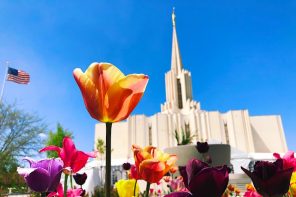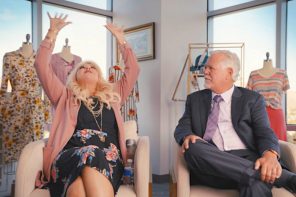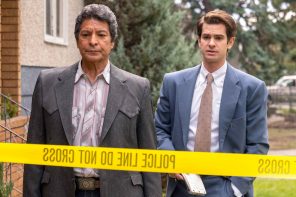On October 5, 2013, almost 200 Mormon women gathered in downtown Salt Lake City on a sunny but crisp Saturday afternoon in order to seek admission to the priesthood session of the semi-annual General Conference of The Church of Jesus Christ of Latter-day Saints.
Calling itself Ordain Women, the group had already requested and been denied tickets to Saturday evening’s male-only priesthood session. Nonetheless the women and their allies walked to the Tabernacle on Temple Square to wait in the stand-by line for last-minute tickets.
Instead they were met by church spokesperson Ruth Todd, who said, “This is no surprise to you, that we won’t be able to offer you a ticket or a place.”
Then, as men and boys strode past them into the Tabernacle where they awaited the opportunity to move to the Conference Center where the session would take place, members of Ordain Women lined up individually or in pairs to request and be denied admission by church representative Doug Peterson.
According to Mike Stevens of Ogden, Utah, who stood nearby and filmed the exchanges, each woman had a brief exchange with Peterson, along the lines of: “I would like to attend the priesthood session.” Peterson’s response?: “I’m sorry, it’s only for men.”
Stevens said that it was particularly striking to watch couples talk to Peterson. “Men would say, ‘I’d like to attend the priesthood session with my wife, because the church says that families are so important,’” only to be told that they would have to enter alone.
A few conversations were more elaborate. Danielle Mooney of Boston pressed Peterson for clarification on several of his answers. When Peterson acknowledged that attendees did not have to hold the priesthood to attend the priesthood session, she replied, “Well, I’m not a priesthood holder, but I am a member of the church.” When he stressed that priesthood session was only for men, regardless of their church status, she said,
“I find that really hurtful that as a woman who’s been a member my whole life who’s faithfully attended, paid my tithing, held a calling—that the fact that I don’t have a Y chromosome would prevent me from being allowed to sit before my prophet and listen to his words.”
Peterson pointed out to Mooney and others that women have their own meeting, the general meeting of the Relief Society, the church’s organization for women—but that meeting is not equal or analogous to the priesthood session. First of all, unlike the priesthood session, it is held only once a year, not semi-annually; it occurs a week before the October General Conference and is preface to rather than a part of Conference weekend.
Furthermore, men not only attend but speak at and preside over the Relief Society General Meeting, while women’s exclusion from the priesthood session is so complete that special arrangements must be made to enforce it. In the April 2007 priesthood session, a musical number was provided by a men’s chorus. The chorus was selected and trained by Brigham Young University professor Rosalind Hall, who also chose the music for the choir—but Hall was not allowed to attend the performance; instead, she was replaced by a male colleague, Ronald Staheli, for that one event. In fact, Hall was not even allowed to be in the conference hall to hear her choir perform.
Women sometimes wept during or after their exchange with Peterson on Saturday afternoon. “I didn’t know just how deeply hurtful that experience of literally being cast out and left out in the cold while men and young boys passed us by would be,” Ordain Women founder Kate Kelly wrote on the group’s blog Sunday morning.
Although Peterson remained affable through all the exchanges, the doors to the Tabernacle closed promptly at 6 p.m. when the priesthood session started, even though about twenty women remained in line. Immediately thereafter, a small garbage truck was parked in front of the door, barring women any access to it.
The group then sang “I Am a Child of God,” a familiar LDS children’s song, before returning to nearby City Creek Park, where some participants watched the priesthood session as it streamed online.
This was the first time the priesthood session was broadcast publicly. Previously, anyone who wanted to watch the session had to attend a private broadcast at an LDS meetinghouse. The decision to make the telecast of the session public was announced after Ordain Women requested and was denied tickets in September.
Although some media outlets referred to the action as a protest, Kelly, an international human rights attorney from Washington, D.C., said it should be more accurately understood as a conversation. “There isn’t a clear way to reach the prophet or the leaders. We can’t simply call them up and ask them to pray about an issue that is of concern to us,” she said.
“This is a way for us to communicate our message and our message is very clear. We chose the name ‘Ordain Women’ for a reason: because we think that nothing but women’s ordination will result in the full equality and enfranchisement of women.”
Kelly said that she was “very disappointed that women’s issues didn’t come to the forefront during the Mormon moment” of 2012 and founded the group earlier this year after her work with women fighting for justice around the world forced her to ask, “What is it I do to assert my self-respect in my own most intimate community?”
The group went public on March 17, 2013, the anniversary of the founding of the Relief Society, with a website featuring profiles of Latter-day Saints who support female ordination. Those profiles allow women to “use our own identities as a tool is a way to assert radical self-respect and a way to claim the narrative as our own.
“What happened to women in the past is that the leadership cast them as outsiders and forced them out, so that they no longer had any control of the narrative of what they were doing. We are claiming our insider status and developing a sense of identity and a narrative that affirms and relies on that status,” Kelly said. Kelly, who graduated from BYU, served a mission for the church in Spain, married in the temple, and is active in her local congregation, most definitely qualifies as an insider.
Women traveled far to be part of the Ordain Women effort. Julia Murphy, who flew in from her home in Heidelberg, Germany, said, “I know it’s a long way. It’s worth it!”
Heather Olson Beal of Nacogdoches, Texas, said, “This wasn’t easy for me to do. I’ve lived with a lot of fear and I can’t say publicly a lot of the things I feel about gender inequality in the church. This is a way to say it.”
“I hope that the leaders of the church would see that we are ready to contribute more,” said Tresa Edmunds of Cameron Park, California. “The priesthood is so often spoken of as a burden that we are spared, but we see it as the power of God that we want to experience and share.”
In a statement about the actions of Ordain Women, Ruth Todd noted that millions of LDS women do not share the group’s views. “Most church members would see such efforts as divisive,” she said. “Even so, these are our sisters and we want them among us, and hope they will find the peace and joy we all seek in the gospel.”
A few women stood near the group and held signs saying such things as, “I don’t need the priesthood to feel equal to my husband.” But Kelly points out that “Equality is not a feeling. Equality can be measured,” and the current treatment of women proves that they are not equal in the LDS church.
That lack of equality also hurts men, notes Mike Stevens. “I resent that I’m told my divine right to the priesthood precludes me from nurturing my children and exercising compassion and all the things the church says are the divine right of women.” While he was happy to support women in their struggle for equality, he added, “I’m also here out of a self-interest in a culture that is healthier for men.”
Despite being turned away from the priesthood session, many women viewed the action as a success. Margaret Toscano, a prominent LDS scholar excommunicated in 2000 for her writings on gender, was buoyed by the experience. “I feel that the spirit of God is moving among us and people’s hearts are being opened,” she said. “There is much cause for hope.”




